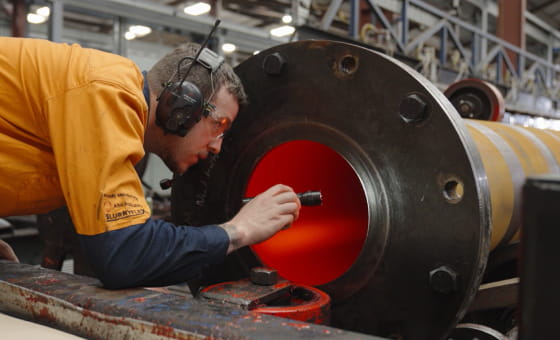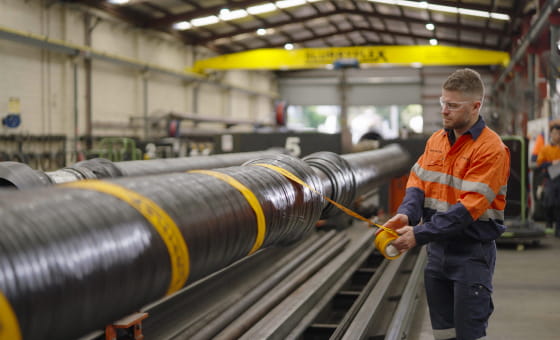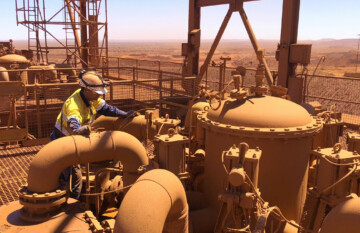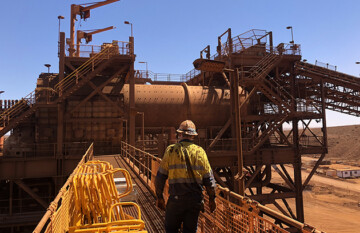Getting the measurements for your hose or pipe flange might not always be as simple as checking the specs stamped on the side. If you need to measure it manually, check out this video where we show you the best way to get it done.
When you’re about to order new hose and pipe, details matter. No one wants their replacement spool to arrive on site only to find that the flange doesn’t quite fit its mate.
That’s why it’s vital to know how to measure a flange correctly, so you can get the right hose or pipe ordered every time.
Before you start
Most ‘off the shelf’ flanges will have the flange and drilling spec stamped onto the outside of the flange. Check the specs and refer to the Standards table for your flange. This can be used to cross reference your own measurements.

Check specs stamped on side of pipe or hose
But sometimes the specs might be obscured, have worn off, or for other reasons aren’t clearly visible. If that’s the case, you’ll need a ruler, a pencil, and the ASME Standards table.

Refer to the Standards table for your flange.
To ensure you measure accurately, use the ‘100mm’ mark as the starting point, because sometimes the tape measure or ruler end is difficult to align or may be damaged.

Measure from the 100mm mark
Step 1: Measure outside diameter
Measure the outside diameter of the flange using a tape measure or ruler. If the hose is connected, you’ll need to use diameter tape. Wrap the tape around the outside of the flange.

Measure the outside diameter (OD)
Step 2: Measure inside diameter
This dimension is used by the fabrication workshop when they have the machined inside diameter and they’re ready to build the hose.
You won’t be able to measure the inside diameter of a flange that is integrally built into the mining hose. And this is not critical when measuring hoses on site.

Measure the inside diameter (ID)
Step 3: Measure pitch circle diameter
Also known as the bolt circle diameter, the pitch circle diameter is the distance from the center of a bolt hole to the center of the adjacent bolt hole.
You can take this dimension by measuring from the inside of one bolt hole to the outside of the adjacent bolt hole. This will give you the same dimension as if you were to measure from center to center. You can’t measure from center to center accurately because you’re simply guessing where the middle of the bolt hole is located.
This is difficult to measure when the flange is connected and there are bolts in the hole.

Measure pitch circle diameter.
Step 4: Measure bolt hole diameter
Simply measure the width of the bolt hole. This diameter can be difficult to measure when the hose is connected and has bolts through it.

Measure bolt hole diameter.
Step 5: Count number of bolt holes
Simply count the number.
Step 6: Measure flange thickness
This can be done easily even when the hose is connected. The flange thickness is always a good indication of what the flange drilling is. If you know the flange diameter, number of holes, and flange thickness, you can generally work out the flange drilling specification.

Measure flange thickness.
However, keep in mind that sometimes manufacturers will use ‘plate cut’ flanges on mining hose. That is, they cut the flange from a steel plate which is generally thinner than what the standard flange thickness is.
Manufacturers will plate cut flanges when:
- The flanges you require aren’t in stock. This could be for an application that is special or rare.
- The hose’s pressure rating is much less than the pressure rating of the flange. For example, for applications like large diameter expansion joints being used at low pressure.
What if it’s a custom pump flange?
If you’re measuring a custom pump flange, measure the flange as usual, but also look at the pump and record the brand, model number, size etc. There should be a nameplate on most pumps which will outline this. Then you can reference the flange specification back to the pump manufacturer’s details as a double check.
This is a simple guide for when the pipe is disconnected and easy to measure. But if your pipe is connected, then you will need a diameter tape and a different method. We’ll cover this method in an upcoming post.

Order it right, first time
Millimetres matter when it comes to ordering the right flange from your hose or pipe supplier. So, it’s important to accurately know how to measure flanges in your process plant or pipeline.
If you’ve got any questions about custom flanges, get in touch with one of our slurry hose or lined piping specialists and they will be happy to provide the information you need to make your next shutdown a breeze.












